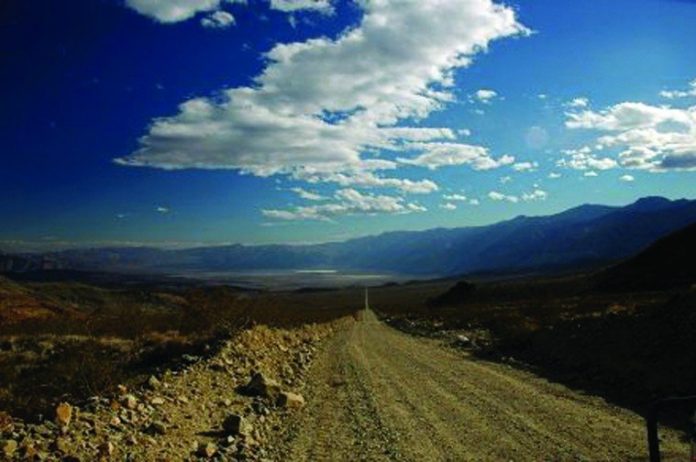We topped of our gas tank in Big Pine two hours ago. The
washboard along Eureka Valley approaching the highest sand dunes in
North America was nasty. Good thing we aired down our tires to
smooth out the ride. Good thing my 1999 Jeep Cherokee 4×4 has all
terrain tires or we would have been stuck in the soft sand.
We topped of our gas tank in Big Pine two hours ago. The washboard along Eureka Valley approaching the highest sand dunes in North America was nasty. Good thing we aired down our tires to smooth out the ride. Good thing my 1999 Jeep Cherokee 4×4 has all terrain tires or we would have been stuck in the soft sand.
We also have an extra spare tire, plus compressed air and tire plugging kits for that occasional flat produced by pointy rocks on these remote roads.
Having plenty of food and water – not to mention beer – for the next few days is paramount.
Now we are approaching the “stair case,” a rock formation in a flash flood canyon that can only be negotiated with a high-clearance, four wheel drive vehicle. This short piece of boulder strewn gravel road is intimidating to the neophyte four wheeler.
I put the Cherokee in four-low, and slowly crawl up the boulders, careful not to scrape the sides of my rig along the narrow passage. Made it. The rest is easy, but we’re still two hours from the hot springs camp in Saline Valley, which is about 20 miles away.
This road that connects Eureka and Saline Valley through Steele Pass is one of many challenging four wheel drive dirt roads in Death Valley National Park. It is also one of the most beautiful and fascinating. The geology, the colors, the desolation and remoteness are awe inspiring.
Our venture into this desert wilderness began in Owens Valley from the town of Big Pine at a 3,900 foot elevation. Taking North Death Valley Road, we climb to 7,400 feet before descending into expansive Eureka Valley.
Had we continued straight, we would have approached Death Valley proper and on to historic Scotty’s Castle. However we made a right toward the Eureka Dunes. The road goes around the dunes, into the canyon “staircase” and onwards to Steel Pass at 5,000 feet.
Once at Steel Pass, the journey is a slow downhill for 15 miles until we reach the hot springs. The low point of Saline Valley is 1,100 feet, nestled against the Inyo Mountains, which tower 10,000 feet above the valley floor. This remote valley is one of the most picturesque in the entire national park.
Across Saline Valley, the county road heads north and south. The north pass toward Big Pine is at 7,500 feet, the south pass toward Panamint Valley is at 6,000 feet. Both require chains in the winter.
And for those that want a real adventure, Lippincott Road takes you up to the “Racetrack,” a flat dry lakebed where winds push rocks and boulders in mysterious patterns. The Lippincott is a steep narrow road not recommended for inexperienced off roaders.
From the Racetrack your journey will bring you to pavement, where you can visit a monster volcanic crater known as Ubehebe Crater. A few miles from there are Scotty’s Castle and the park entrance in into Death Valley proper.
Once in Death Valley, modern facilities such as gas stations, campgrounds, restaurants and motels are found at Stovepipe Wells and Furnace Creek. Badwater is the lowest point in the United States at 284 feet below sea level.
But the real fun is not the pavement – it’s the off road adventures, exploring remote canyons and passes, and going off the beaten path. Death Valley National Park is a geologist’s and nature photographer’s paradise, especially in spring with the desert bloom.
But it can be a nightmare for the ill-prepared. This region can be hell with summer temperatures soaring into the 120s. In the winter, temperatures drop below freezing and mountain passes may require chains. All too often, park rangers help people in trouble due to vehicle breakdowns or inadequate supplies. So the Boy Scout motto “Be Prepared” takes a significant meaning when venturing into this remote and beautiful desert wilderness.
With winter upon us, October through April are the best months to visit this park, so take a road trip, be prepared and explore Death Valley.














